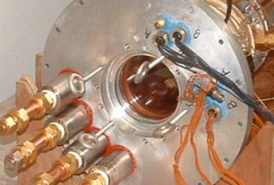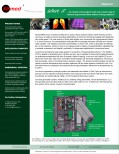Almost fifteen years of research effort at two dozen clinical research sites in North America and Europe have revealed numerous beneficial applications of pulmonary functional imaging with hyperpolarized noble gases. The vast majority of those pilot studies were conducted with hyperpolarized helium-3, a scarce resource. As hyperpolarized noble gas MRI becomes increasingly widespread and clinically valuable, the imaging community must transition to xenon-129, which is abundant and affordable.
- Composition: MagniLium is Xemed’s hyperpolarized helium-3 magnetic resonance imaging contrast agent. Helium-3 is the decay product of tritium, which is a strategic material produced for use in modern nuclear weapons. Xemed’s proprietary technology enhances the nuclear magnetization of helium-3 by a factor approaching one million times, so that it is visible in an MRI scanner.
- Sustainability: Since MagniLium is a byproduct of maintaining the nuclear weapons stockpile, its supply is fixed. Dedicated production of helium-3 for medical imaging applications would be cost-prohibitive.
- Production: MagniLium achieves its high level of magnetization by Spin Exchange Optical Pumping, a process that utilizes a laser beam to optically produce an alignment of the spin axis of rubidium and potassium atoms. This alignment of spin is then exchanged to the nucleus of helium-3 in a batch process, to yield the magnetic enhancement. Xemed’s technology has enabled a scaling up of this process by a large factor, allowing efficient production of fifty-liter volumes in as little as eight to twelve hours.
- Delivery & lifetime: MagniLium has a useful lifetime that can last several tens of hours from the time of production. The European network has developed highly reliable shipping of hyperpolarized helium-3 from production site to clinic.
- Imaging Protocols: The physiological surroundings of the xenon atoms in MagniLium modify its physically observable characteristics. By manipulating and observing quantities such as concentration, diffusion, and relaxation, and the evolution of these quantities with time, MRI scanner protocols can investigate a broad range of disease-relevant lung properties.
- Regulatory Status: Thousands of studies have been conducted worldwide with hyperpolarized helium-3 produced from various technologies and under several INDs. Xemed is not presently pursuing a separate IND for hyperpolarized helium-3.
- Safety: Hyperpolarized helium-3 is typically formulated as one-third liter of polarized gas diluted with pure nitrogen to a volume of one liter, and administered without oxygen. Hyperpolarized helium-3 is well tolerated.
- Intellectual Property: Xemed’s system for producing MagniLium, the HeliBox-Z100, incorporates proprietary laser technology for which Xemed is the exclusive licensee.
Xemed has suspended its pursuit of MagniLium as a commercializable magnetic resonance imaging agent. Xemed is continuing to refine its HeliBox-Z100 hyperpolarizer technology in order to meet the needs of fundamental nuclear physics experiments with electron beams and studies of condensed matter with polarized neutron scattering.

